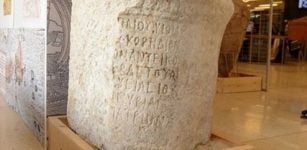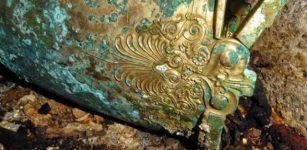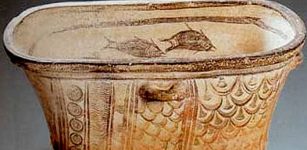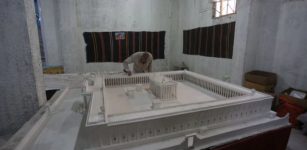Biblical City In Zanoah Offers Archaeological Evidence Of Moses’ Journey To The Promised Land
Jan Bartek – MessageToEagle.com – Recent archaeological excavations conducted by the Israeli Antiquities Authority have yielded significant findings from the Biblical city of Zanoah, referenced in the Old Testament. The discoveries include stone walls, pottery, and artifacts dating back over 3,200 years.
According to Biblical chronology, the Israelites are believed to have reached the Promised Land, also known as Canaan, circa 1406 to 1407 B.C., following a 40-year period of desert wandering.
magined painting by Frans Pourbus the Elder (c. 1565–80) depicting the Israelite’s God showing Moses the Promised Land. Credit: CC BY 3.0
Among the notable discoveries is a fragmented jar handle bearing the name of a king mentioned in the Bible, providing additional corroboration for the Biblical narrative of Moses.
The Exodus account, as detailed in the Biblical books of Exodus, Leviticus, Numbers, and Deuteronomy, commences with the Israelites in Egyptian bondage. Following a series of ten calamitous plagues, the Pharaoh accepted reluctantly their release, whereupon Moses guided them across the miraculously-parted Red Sea.
The excavation area. Credit: Israeli Antiquities Authority
Biblical texts further recount that upon reaching the Sinai Peninsula, the Israelites journeyed to Mount Sinai, where Moses is said to have received the Ten Commandments.
Moses and his people continued to the southern border of Canaan, but being too scared to enter, were condemned to spending decades in the wilderness by God.
Following an extended stay at the oasis of Kadesh Barnea, the Israelites proceeded to the eastern frontier of Canaan. It was at this location that Moses, their leader, passed away and was buried on Mount Nebo.
The subsequent narrative, as chronicled in the Book of Joshua, delineates Joshua’s assumption of leadership over the Israelites. Under his guidance, the people traversed the River Jordan, entering the Promised Land, and subsequently conquered Jericho. It is noteworthy that within this same text, the Book of Joshua, there is a specific reference to Zanoah.
Archaeological investigations were conducted in the region in 2019, with findings released in March 2020.
One if the city’s walls. Credit: Israeli Antiquities Authority
The team uncovered structural elements made of aligned, large white stones, interpreted as support walls for agricultural terraces. These structures created level cultivation areas and reduced soil erosion on steep slopes.
Ceramic artifacts were also found, including a notable piece with a handle impression reading ‘of the King,’ likely commemorating King Hezekiah’s reign in Judah around 701 B.C.
The site contained numerous ceramic fragments, with about 20 percent dating to the supposed period of Israelite arrival after their 40-year journey in the wilderness. The remaining artifacts spanned the next 900 years of production.
Among the discoveries was an ornate fragment of a white limestone cosmetic container.
Archaeological unearthed remarkably well-preserved pottery artifacts, notably featuring an LMLK stamp on the jar handle, a discovery of significant rarity in the Judean foothills. These markings, which are ancient Hebrew seals, denote “of the King.” Credit: Israeli Antiquities Authority
‘It has a wide rim adorned with a decoration of three concentric bands separated by gaps: the external and internal bands are narrow and feature a rope decoration, while the central band is wide and features an intermittent grid pattern,’ the researchers wrote in their study.
The archaeological excavation yielded a diverse array of artifacts, including ceramic vessels and metallic objects. Among the ceramic findings were bowls and jugs, with one specimen exhibiting perforations that suggest its potential utilization as a lighting device. The metallic discoveries encompassed bronze ornamental items, specifically a ring and a fragment of an earring, although the precise period of their manufacture was not ascertained by the researchers.
The wall from the north. Credit: Israeli Antiquities Authority
Additional evidence of human habitation in the region was manifested in the form of iron implements, nails of varying dimensions, and bronze strips employed in iron welding processes. The research team explained that while a portion of the artifacts may have originated from the ruins and subsequently been displaced down the slope over time, the majority of the findings, particularly those dating to the early Byzantine era, are associated with agricultural activities conducted on the hillsides.
See also: More Archaeology News
In their press release, the researchers further noted that the substantial quantity of artifacts recovered underscores the site’s historical importance and emphasizes its potential archaeological significance. This assessment suggests that further investigation of the site may yield valuable insights into the region’s historical and cultural development.
Written by Jan Bartek – MessageToEagle.com – AncientPages.com Staff Writer















